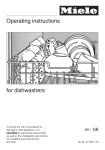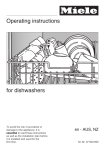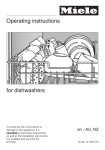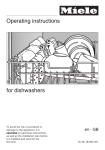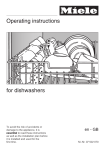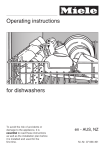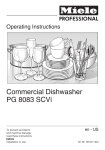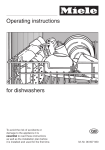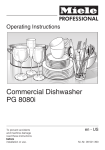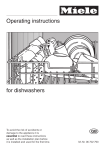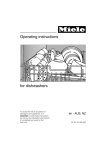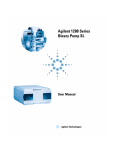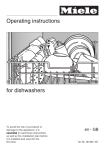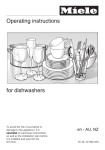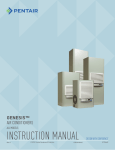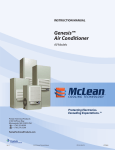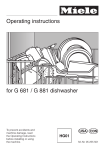Download Miele G 1173 SCVi
Transcript
Operating instructions
for dishwashers
To avoid the risk of accidents or
damage to the appliance, it is
essential to read these instructions
as well as the installation plan before
it is installed and used for the
first time.
en - AU, NZ
M.-Nr. 07 499 220
Contents
Description of the appliance . . . . . . . . . . . . . . . . . . . . . . . . . . . . . . . . . . . . . . . . . 4
Appliance overview . . . . . . . . . . . . . . . . . . . . . . . . . . . . . . . . . . . . . . . . . . . . . . . . . 4
Control panel . . . . . . . . . . . . . . . . . . . . . . . . . . . . . . . . . . . . . . . . . . . . . . . . . . . . . . 5
Warning and Safety instructions . . . . . . . . . . . . . . . . . . . . . . . . . . . . . . . . . . . . . 6
Caring for the environment . . . . . . . . . . . . . . . . . . . . . . . . . . . . . . . . . . . . . . . . . 11
Disposal of the packing material . . . . . . . . . . . . . . . . . . . . . . . . . . . . . . . . . . . . . . 11
Disposal of your old appliance . . . . . . . . . . . . . . . . . . . . . . . . . . . . . . . . . . . . . . . 11
Energy saving washing . . . . . . . . . . . . . . . . . . . . . . . . . . . . . . . . . . . . . . . . . . . . . 12
Before using for the first time. . . . . . . . . . . . . . . . . . . . . . . . . . . . . . . . . . . . . . . 13
To open the door . . . . . . . . . . . . . . . . . . . . . . . . . . . . . . . . . . . . . . . . . . . . . . . . . . 13
To close the door . . . . . . . . . . . . . . . . . . . . . . . . . . . . . . . . . . . . . . . . . . . . . . . . . . 13
Water softener . . . . . . . . . . . . . . . . . . . . . . . . . . . . . . . . . . . . . . . . . . . . . . . . . . . . 14
To programme the water hardness level . . . . . . . . . . . . . . . . . . . . . . . . . . . . . 15
Checking the programmed water hardness level . . . . . . . . . . . . . . . . . . . . . . 16
Before using the appliance for the first time, you require:. . . . . . . . . . . . . . . . . . . 17
Filling the salt reservoir . . . . . . . . . . . . . . . . . . . . . . . . . . . . . . . . . . . . . . . . . . . . . 17
Salt refill indicator F . . . . . . . . . . . . . . . . . . . . . . . . . . . . . . . . . . . . . . . . . . . . . . . 18
Rinse aid . . . . . . . . . . . . . . . . . . . . . . . . . . . . . . . . . . . . . . . . . . . . . . . . . . . . . . . . 19
Adding rinse aid . . . . . . . . . . . . . . . . . . . . . . . . . . . . . . . . . . . . . . . . . . . . . . . . . . 19
Rinse aid indicator (. . . . . . . . . . . . . . . . . . . . . . . . . . . . . . . . . . . . . . . . . . . . . . . 20
Setting the rinse aid dosage . . . . . . . . . . . . . . . . . . . . . . . . . . . . . . . . . . . . . . . . . 21
Loading the dishwasher . . . . . . . . . . . . . . . . . . . . . . . . . . . . . . . . . . . . . . . . . . . 22
Items not suitable for dishwashers: . . . . . . . . . . . . . . . . . . . . . . . . . . . . . . . . . . . . 23
Upper basket . . . . . . . . . . . . . . . . . . . . . . . . . . . . . . . . . . . . . . . . . . . . . . . . . . . . . 24
Hinged cup rack . . . . . . . . . . . . . . . . . . . . . . . . . . . . . . . . . . . . . . . . . . . . . . . . 24
Positioning rail (depending on model) . . . . . . . . . . . . . . . . . . . . . . . . . . . . . . . 24
Adjusting the upper basket . . . . . . . . . . . . . . . . . . . . . . . . . . . . . . . . . . . . . . . 25
Lower basket . . . . . . . . . . . . . . . . . . . . . . . . . . . . . . . . . . . . . . . . . . . . . . . . . . . . . 26
Hinged spikes. . . . . . . . . . . . . . . . . . . . . . . . . . . . . . . . . . . . . . . . . . . . . . . . . . 26
Removable spiked insert . . . . . . . . . . . . . . . . . . . . . . . . . . . . . . . . . . . . . . . . . 27
Bottle holder (depending on model). . . . . . . . . . . . . . . . . . . . . . . . . . . . . . . . . 27
Cutlery . . . . . . . . . . . . . . . . . . . . . . . . . . . . . . . . . . . . . . . . . . . . . . . . . . . . . . . . . . 28
Cutlery tray (depending on model). . . . . . . . . . . . . . . . . . . . . . . . . . . . . . . . . . 28
Cutlery basket (depending on model) . . . . . . . . . . . . . . . . . . . . . . . . . . . . . . . 29
Operation . . . . . . . . . . . . . . . . . . . . . . . . . . . . . . . . . . . . . . . . . . . . . . . . . . . . . . . 30
Detergent . . . . . . . . . . . . . . . . . . . . . . . . . . . . . . . . . . . . . . . . . . . . . . . . . . . . . . . . 30
Adding detergent. . . . . . . . . . . . . . . . . . . . . . . . . . . . . . . . . . . . . . . . . . . . . . . . . . 32
Switching on . . . . . . . . . . . . . . . . . . . . . . . . . . . . . . . . . . . . . . . . . . . . . . . . . . . . . 33
2
Contents
Selecting a programme . . . . . . . . . . . . . . . . . . . . . . . . . . . . . . . . . . . . . . . . . . . . . 33
Starting a programme . . . . . . . . . . . . . . . . . . . . . . . . . . . . . . . . . . . . . . . . . . . . . . 33
At the end of a programme . . . . . . . . . . . . . . . . . . . . . . . . . . . . . . . . . . . . . . . . . . 34
Switching off . . . . . . . . . . . . . . . . . . . . . . . . . . . . . . . . . . . . . . . . . . . . . . . . . . . . . 34
Unloading the dishwasher . . . . . . . . . . . . . . . . . . . . . . . . . . . . . . . . . . . . . . . . . . . 34
Interrupting a programme . . . . . . . . . . . . . . . . . . . . . . . . . . . . . . . . . . . . . . . . . . . 35
Changing a programme . . . . . . . . . . . . . . . . . . . . . . . . . . . . . . . . . . . . . . . . . . . . 35
Additional functions . . . . . . . . . . . . . . . . . . . . . . . . . . . . . . . . . . . . . . . . . . . . . . . . 36
Buzzer. . . . . . . . . . . . . . . . . . . . . . . . . . . . . . . . . . . . . . . . . . . . . . . . . . . . . . . . 36
Factory default setting . . . . . . . . . . . . . . . . . . . . . . . . . . . . . . . . . . . . . . . . . . . 37
Cleaning and care . . . . . . . . . . . . . . . . . . . . . . . . . . . . . . . . . . . . . . . . . . . . . . . . 38
Cleaning the wash cabinet . . . . . . . . . . . . . . . . . . . . . . . . . . . . . . . . . . . . . . . . . . 38
Cleaning the door and the door seal . . . . . . . . . . . . . . . . . . . . . . . . . . . . . . . . . . . 38
Cleaning the control panel and door front . . . . . . . . . . . . . . . . . . . . . . . . . . . . . . . 39
Cleaning the filters in the wash cabinet . . . . . . . . . . . . . . . . . . . . . . . . . . . . . . . . . 40
Cleaning the spray arms . . . . . . . . . . . . . . . . . . . . . . . . . . . . . . . . . . . . . . . . . . . . 42
Problem solving guide . . . . . . . . . . . . . . . . . . . . . . . . . . . . . . . . . . . . . . . . . . . . 43
Technical problems . . . . . . . . . . . . . . . . . . . . . . . . . . . . . . . . . . . . . . . . . . . . . . . . 43
The dishwasher does not fill/drain. . . . . . . . . . . . . . . . . . . . . . . . . . . . . . . . . . . . . 45
General problems . . . . . . . . . . . . . . . . . . . . . . . . . . . . . . . . . . . . . . . . . . . . . . . . . 46
Noises . . . . . . . . . . . . . . . . . . . . . . . . . . . . . . . . . . . . . . . . . . . . . . . . . . . . . . . . . . 47
Unsatisfactory washing result . . . . . . . . . . . . . . . . . . . . . . . . . . . . . . . . . . . . . . . . 48
Maintenance . . . . . . . . . . . . . . . . . . . . . . . . . . . . . . . . . . . . . . . . . . . . . . . . . . . . . 51
Cleaning the water inlet filter . . . . . . . . . . . . . . . . . . . . . . . . . . . . . . . . . . . . . . . . . 51
Cleaning the drain pump and non-return valve . . . . . . . . . . . . . . . . . . . . . . . . . . . 52
Comparison tests. . . . . . . . . . . . . . . . . . . . . . . . . . . . . . . . . . . . . . . . . . . . . . . . . 53
Programme chart . . . . . . . . . . . . . . . . . . . . . . . . . . . . . . . . . . . . . . . . . . . . . . . . . 56
After sales service . . . . . . . . . . . . . . . . . . . . . . . . . . . . . . . . . . . . . . . . . . . . . . . . 60
Repairs . . . . . . . . . . . . . . . . . . . . . . . . . . . . . . . . . . . . . . . . . . . . . . . . . . . . . . . 60
Future updates . . . . . . . . . . . . . . . . . . . . . . . . . . . . . . . . . . . . . . . . . . . . . . . . . 60
Optional accessories . . . . . . . . . . . . . . . . . . . . . . . . . . . . . . . . . . . . . . . . . . . . . . 61
Electrical connection . . . . . . . . . . . . . . . . . . . . . . . . . . . . . . . . . . . . . . . . . . . . . . 62
Plumbing. . . . . . . . . . . . . . . . . . . . . . . . . . . . . . . . . . . . . . . . . . . . . . . . . . . . . . . . 63
The Miele waterproof anti-leak system . . . . . . . . . . . . . . . . . . . . . . . . . . . . . . . . . 63
Connection to the water supply . . . . . . . . . . . . . . . . . . . . . . . . . . . . . . . . . . . . . . . 63
Drainage . . . . . . . . . . . . . . . . . . . . . . . . . . . . . . . . . . . . . . . . . . . . . . . . . . . . . . . . 64
Technical data . . . . . . . . . . . . . . . . . . . . . . . . . . . . . . . . . . . . . . . . . . . . . . . . . . . 65
3
Description of the appliance
Appliance overview
a Upper spray arm (not visible)
g Filter combination
b Cutlery tray (depending on model)
h Data plate
c Upper basket
i Rinse aid reservoir
d Middle spray arm
j Dual compartment detergent
dispenser
e Air inlet for drying
(depending on model)
f Lower spray arm
4
k Salt reservoir
Description of the appliance
Control panel
a Check/Refill indicators
Symbols
b Programmes
U
On
V Off
YX Programme selector button
c Programme selector button YX
d On button U with indicator light
e Off button V
Check/Refill indicators
2/2
(
F
Inlet / Drain
Rinse aid
Salt
Programmes
The symbols are described in greater
detail in the relevant sections of these
instructions.
Auto
*
9
,
E
1
Sensor wash
Normal
Quick wash
Pots & pans
Light wash
Pre-wash
This instruction book applies to several different dishwasher models.
The specific dishwasher models below are referred to as follows:
G 1173 etc. = G 1XXX
G 2173 etc. = G 2XXX
The model numbers G 1XXX and G 2XXX used in this book refer to the model
designation specified on the data plate of the appliance (and not the
description on the control panel).
The data plate is located at the top right hand side of the door.
5
Warning and Safety instructions
Safety with children
This appliance conforms to current
safety requirements. Inappropriate
use can, however, lead to personal
injury and damage to property.
To avoid the risk of accidents and
damage to the appliance, please
read these instructions carefully
before using it for the first time. They
contain important information on its
safety, use and maintenance.
Keep these instructions in a safe
place and pass them on to any
future owner.
Correct application
~ This dishwasher is intended
exclusively for cleaning domestic
crockery and cutlery in a domestic
household. Using it for purposes other
than those for which it was designed,
as well as any alterations or
conversions to the appliance, would be
unauthorised and could cause harm.
The manufacturer cannot be held liable
for damage resulting from improper or
incorrect use of the appliance.
~ This dishwasher is not intended for
use by persons (including children)
with reduced physical, sensory or
mental capabilities, or lack of
experience and knowledge, unless they
are supervised whilst using it or they
have been given instruction concerning
its use by a person responsible for their
safety.
6
~ This appliance is not a toy! To avoid
the risk of injury, keep children well
away and do not allow them to play in
or around the dishwasher, or to use the
controls. They will not understand the
potential dangers posed by it. They
should be supervised whenever you
are working in the kitchen. There is a
danger that children playing might shut
themselves in the dishwasher.
~ Older children may only use the
dishwasher when its operation has
been clearly explained to them and
they are able to use it safely,
recognising the dangers of misuse.
~ Keep children away from
detergents. Dishwasher detergents
contain irritant and corrosive
ingredients which can cause burning in
the mouth, nose and throat if
swallowed, or inhibit breathing. Keep
children away from the dishwasher
when the door is open. There could still
be detergent residues in the cabinet.
Consult a doctor immediately if your
child has swallowed or inhaled
detergent.
Warning and Safety instructions
Technical safety
~ Before setting up the appliance,
check it for any externally visible
damage. Under no circumstances
should you use a damaged appliance.
A damaged appliance could be
dangerous.
~ The dishwasher must only be
plugged into the electricity supply via a
suitable switched socket. The electrical
socket must be easily accessible after
the dishwasher has been installed so
that it can be disconnected from the
electricity supply at any time. (See
"Electrical connection").
~ There must be no electrical sockets
behind the dishwasher. Danger of
overheating and fire risk if the
dishwasher were to be pushed up
against a plug.
~ The dishwasher must not be
installed under a hob. The high radiant
temperatures which are sometimes
generated by a hob could damage the
dishwasher. For the same reason it
should not be installed next to open
fires or other appliances which give off
heat, such as heaters etc.
~ Do not connect the dishwasher to
the mains supply until it has been fully
installed.
~ Before connecting the appliance,
check that the connection data on the
data plate (voltage and connected
load) match the mains electricity
supply. If in any doubt, consult a
qualified electrician.
~ The electrical safety of this
appliance can only be guaranteed
when continuity is complete between it
and an effective earthing system. It is
most important that this basic safety
requirement is present and regularly
tested and where there is any doubt the
electrical system in the house should
be checked by a qualified electrician.
The manufacturer cannot be held liable
for the consequences of an inadequate
earthing system (e.g. electric shock).
~ Do not connect the appliance to the
mains electricity supply by a
multi-socket unit or an extension lead.
These do not guarantee the required
safety of the appliance (e.g. danger of
overheating).
7
Warning and Safety instructions
~ This equipment may only be
installed in mobile installations such as
ships if a risk assessment of the
installation has been carried out by a
suitably qualified engineer.
~ A damaged appliance could be
~ The plastic housing of the water
connection contains an electrical
component. The housing must not be
dipped in water.
~ Unauthorised repairs could result in
~ There are live wires in the water inlet
hose. Never cut the water inlet hose,
even if it is too long.
~ The integrated Waterproof System
offers protection from water damage,
provided the following conditions are
met:
– The dishwasher is correctly installed
and plumbed in.
– The dishwasher is properly
maintained and parts are replaced
where it can be seen that this is
necessary.
– The tap has been turned off when
the appliance is not used for a longer
period of time (e.g. during holidays).
The Waterproof system will work even if
the appliance is switched off. However,
the appliance must remain connected
to the electricity supply.
8
dangerous. If the dishwasher gets
damaged, switch it off at the mains and
call your Miele Chartered Agent or the
Miele Customer Contact Centre.
unforeseen dangers for the user, for
which Miele cannot accept liability.
Repairs should only be undertaken by a
Miele approved service technician.
~ Faulty components must only be
replaced by genuine Miele original
spare parts. The manufacturer can only
guarantee the safety of the appliance
when Miele replacement parts are
used.
~ Always disconnect the dishwasher
from the electrical supply for
maintenance work (switch off at the wall
socket and remove the plug).
~ If the connection cable is damaged
it must be replaced with a Miele cable
by a Miele approved service technician
only.
~ In areas which may be subject to
infestation by cockroaches or other
vermin, pay particular attention to
keeping the appliance and its
surroundings in a clean condition at all
times. Any damage which may be
caused by cockroaches or other vermin
will not be covered by the guarantee.
Warning and Safety instructions
Installation
Correct use
~ The dishwasher must be installed
and connected in compliance with the
installation instructions.
~ Do not use solvents in the
~ The dishwasher must be correctly
detergent. Dishwasher detergents
contain irritant or corrosive ingredients
which can cause burning in the nose,
mouth and throat if swallowed, or inhibit
breathing. Consult a doctor immediately if detergent has been swallowed or
inhaled.
aligned to ensure problem-free
operation.
~ In order to ensure stability,
built-under and integrated dishwashers
must only be installed under a
continuous worktop which is secured to
adjacent cabinetry.
~ If you want to convert your
freestanding dishwasher to a
built-under ("U") model, you will need to
order the appropriate conversion kit. If
you remove the existing plinth, you
must replace it with a U-model plinth.
This is necessary to avoid the risk of
injury caused by protruding metal
parts.
dishwasher. Danger of explosion.
~ Do not inhale or ingest dishwasher
~ Avoid leaving the door open
unnecessarily, as you could trip over it.
~ Do not sit or lean on the opened
door. This could cause the dishwasher
to tip and be damaged, and you could
get injured.
~ Only use detergent and rinse aid
formulated for domestic dishwashers.
Do not use washing-up liquid.
~ Do not use commercial or industrial
detergents as these may cause
damage, and there is a risk of severe
chemical reaction.
~ Do not fill the rinse aid reservoir with
powder or liquid detergent. This will
cause serious damage to the reservoir.
9
Warning and Safety instructions
~ Inadvertently filling the salt reservoir
with powder or liquid dishwasher
detergent will damage the water
softener. Make sure you have picked
up the correct packet of dishwasher
salt before filling the salt reservoir!
~ Please only use special coarse
grained dishwasher salt for reactivation,
as other salts may contain insoluble
additives which can impair the
functioning of the softener.
~ In an appliance with a cutlery basket
(depending on model) cutlery is
cleaned and dried more efficiently if
placed in the basket with the handles
downwards. However, to avoid the risk
of injury, place knives and forks etc.
with the handles upwards.
~ Plastic items which cannot withstand
being washed in hot water, such as
disposable plastic containers, or plastic
cutlery and crockery should not be
cleaned in the dishwasher. The high
temperatures in the dishwasher may
cause them to melt or lose shape.
~ On models with "Delay start", make
sure that the dispenser is dry before
adding detergent. Wipe dry if
necessary. Detergent will clog if poured
into a damp dispenser and may not be
thoroughly dispersed.
10
Accessories
~ Only use genuine Miele spare parts
and accessories with this appliance. If
spare parts or accessories from other
manufacturers are used, this will
invalidate the guarantee, and Miele
cannot accept liability.
Disposal of your old
dishwasher
~ Make the door lock inoperative so
that children cannot accidentally shut
themselves in. Make appropriate
arrangements for the disposal of the
appliance.
The manufacturer cannot be held
liable for damage caused by
non-compliance with these Warning
and Safety instructions.
Caring for the environment
Disposal of the packing
material
The packing material protects the dryer
from transport damages. The transport
and protective packing has been
selected from materials which are
environmentally friendly for disposal
and can normally be recycled.
The packaging consists of the following
materials:
Disposal of your old appliance
Electrical and electronic machines
often contain materials which, if
handled or disposed of incorrectly
could be potentially hazardous to
human health and to the environment.
They are, however, essential for the
correct functioning of your appliance.
Therefore, please do not dispose of it
with your household waste.
Outer packaging:
– Corrugated cardboard made from up
to 100% recyclable material:
or: Polyethylene (PE) protective wrap
– Polyproplylene (PP) strapping
Inner packaging:
– Chlorine and fluorine free expanded
polystyrene (EPS)
– Base, lid frame and support battens
made from untreated natural wood
from renewable forests
– Polyethylene (PE) protective wrap
Rather than just throwing these
materials away, please ensure they are
offered for recycling.
Please dispose of it at your local
community waste collection/recycling
centre or contact you dealer for advice.
Ensure that it presents no danger to
children while being stored for
disposal. You can also contact your
Chartered Agent for advice.
It should be unplugged or
disconnected from the mains electricity
supply by a competent person.
To enable sorting by type of plastic for
recycling, all plastic parts of the
appliance are labelled with international
standard symbols.
11
Caring for the environment
Energy saving washing
This dishwasher is exceptionally
economical in its use of water and
electricity.
You can make the most of your
appliance by following these tips:
^ If your household water system is
suitable, this dishwasher can be
connected to a hot water supply for
further economies. If the water is
heated by for example, solar panels,
this would be energy efficient.
However, if your water is heated by
electricity we would recommend
connection to cold water.
^ For most economical dishwashing,
make full use of the baskets without
overloading the dishwasher.
^ Choose the programme to suit the
type of crockery being washed and
the degree of soiling.
^ Select the Normal programme for
energy-saving dishwashing.
^ Follow the detergent manufacturer's
recommendations on detergent
dosage.
^ When using powder or liquid
detergent you can use 1/3 less
detergent if baskets are only half full.
12
Before using for the first time
To open the door
To close the door
^ Push the baskets right in.
^ Then lift the door upwards and push
until it clicks into position.
^ Pull the handle.
If the door is opened during operation
all functions are automatically
interrupted.
13
Before using for the first time
Water softener
In order to achieve good cleaning
results, the dishwasher needs to
operate with soft water. Hard water
results in the build-up of calcium
deposits on crockery and in the
dishwasher.
Mains water with a hardness level
higher than 0.7 mmol/l (4 °d –
German scale) needs to be softened.
This takes place automatically in the
integrated water softener.
– The water softener requires
dishwasher salt.
If you use "3 in 1" or "4 in 1" products
in your dishwasher, you should still
add salt in order to achieve optimum
results.
– The dishwasher must be
programmed for the water hardness
in your area.
– Your local water authority will be able
to advise you of the water hardness
level in your area.
Where the water hardness fluctuates
e.g. between 1.4 - 3.1 mmol/l (8 - 17 °d
German scale) always programme the
dishwasher to the higher value
(3.1 mmol/l in this example).
In the event of a fault, it will help the
service technician if you know the
hardness of your local water supply.
^ Enter the water hardness below:
mmol/l or °d
14
The dishwasher is set at the factory
for a hardness level of
0.2 - 0.7 mmol/l (1 - 4 °d).
If this setting corresponds to the
hardness of your water you do not need
to do anything more.
If your water is harder or softer, you will
need to programme the water hardness
level. See following section.
Before using for the first time
To programme the water hardness
level
Each time a button is pressed, one of
the indicator lights will flash and light
up in the control panel. However, only
the indicator lights mentioned in the
following programming process stages
are significant.
The programming procedure can be
cancelled at any time by pressing the
Off button V. The procedure can
then be re-started from the beginning
again.
^ Switch the dishwasher off with the Off
button V.
^ Press the programme selector button
;? in, and whilst holding it in
switch the dishwasher on using the
On button U.
Keep the programme selector button
;? pressed in until the lower right
hand programme indicator comes
on.
If this does not happen, start the
procedure from the beginning again.
^ Press the programme selector button
;? twice briefly.
The Inlet/drain check light 2/2 will
flash twice briefly at intervals, and the
upper right hand programme indicator
will flash briefly once at intervals
(factory default setting).
The number of times the upper right
hand programme indicator flashes tells
you the water hardness level which has
been set (see chart).
°d
mmol/l
°f
Flashing
1- 4
0.2 - 0.7
2-
7
Once briefly
5- 7
0.9 - 1.3
9- 13
Twice briefly
8 - 11
1.4 - 2.0
14- 20
3 times briefly
12 - 15
2.2 - 2.7
22- 27
4 times briefly
16 - 20
2.9 - 3.6
29- 36
5 times briefly
21 - 25
3.8 - 4.5
38- 45
6 times briefly
26 - 30
4.7 - 5.4
47- 54
7 times briefly
31 - 36
5.6 - 6.5
56- 65
8 times briefly
37 - 45
6.7 - 8.1
67- 81
9 times briefly
46 - 70
8.3 - 12.6
83-126 Once for longer
^ Press the programme selector button
;? briefly to select the number of
flashes which equates to your water
hardness level.
Each press of the button moves you
up a level. When the highest water
hardness level is reached, the setting
starts from the beginning again.
Example:
If your water hardness level is
4.0 mmol/l (22 °d), the upper right
hand programme indicator should
flash briefly six times at intervals.
^ Switch the dishwasher off with the Off
button V.
^ Press the programme selector button
;? for at least 1 second until the
Inlet/drain check light 2/2 comes
on.
15
Before using for the first time
Checking the programmed water
hardness level
^ Switch the dishwasher off with the Off
button V.
^ Press the programme selector button
;? in, and whilst holding it in
switch the dishwasher on using the
On button U.
Keep the programme selector button
;? pressed in until the lower right
hand programme indicator comes
on.
^ Press the programme selector button
;? twice briefly.
The upper right hand programme
indicator will flash for the number of
times which corresponds to the water
hardness level which has been set (see
chart).
^ Switch the dishwasher off with the Off
button V.
16
Before using for the first time
Before using the appliance for
the first time, you require:
– Approx. 2 litres of water,
– Approx. 2 kg dishwasher salt,
– Domestic dishwasher detergent,
– Rinse aid formulated for domestic
dishwashers.
Every dishwasher is tested at the
factory.
There will be residual water in the
appliance from this test. It is not an
indication that it has been used
previously.
Filling the salt reservoir
If you use combination products
which have salt in them, such as "3
in 1" or "4 in 1" products in your
dishwasher, you should still add salt
in order to achieve optimum results
and to ensure that the water softener
continues to function correctly.
Important: Before filling the salt
reservoir with dishwasher salt for the
first time, you must fill it with
approx. 2 litre of water to enable the
salt to dissolve. Once the
dishwasher has been used, there is
always sufficient water in the
reservoir.
,Inadvertently filling the salt
reservoir with powder or liquid
dishwasher detergent will damage
the water softener.
,Miele recommends using
specially designed dishwasher salt
to maximize the performance of your
dishwasher and to prevent build-up
of calcium and limescale in the
dishwasher cabinet, especially if you
live in hard water area.
Dishwasher salt can be purchased
online at www.miele.com.au
(depending on country) or via the
Miele Spare Parts Department.
If the water in your area is very soft
and constantly lower than
0.7 mmol/l (4 °d) you do not need
to add salt.
The water softener must, however,
still be programmed to correspond
to the water hardness level in your
area.
17
Before using for the first time
^ Remove the lower basket and
unscrew the salt reservoir cap.
Water or saline solution will run out
of the reservoir when the cap is
removed. It should therefore only be
removed in order to refill the salt
reservoir.
^ Fill the reservoir with approx. 2 litres
of water (first use only).
Salt refill indicator F
^ Fill the salt reservoir with dishwasher
salt when the salt indicator light F
comes on. (If it comes on during a
programme, wait until the end of the
programme).
After the reservoir has been filled, the
water softener is automatically
reactivated the next time the
dishwasher is run. The salt indicator
light may still be illuminated during this
process. It will go out once the salt
concentration has reached the correct
level.
The salt indicator is deactivated when
the dishwasher has been programmed
to a water hardness level below
0.7 mmol/l (4 °d).
,After filling the salt reservoir, run
^ Place the funnel provided over the
salt reservoir and carefully fill with
salt until the reservoir is full. The salt
reservoir holds approx. 2 kg of salt.
^ Clean any excess salt from around
the reservoir opening and then screw
the cap on again firmly.
^ Run the Quick wash programme immediately (without any crockery in
the dishwasher) to remove any traces
of salt from the cabinet.
18
the Quick wash programme immediately (without any crockery in the
dishwasher) to remove any traces of
salt from the cabinet.
Before using for the first time
Rinse aid
Rinse aid is necessary to ensure water
does not cling and leave marks on
crockery during the drying phase and
helps crockery dry faster after it has
been washed.
Rinse aid is poured into the storage
reservoir and the amount set is
dispensed automatically.
If you only ever use "2 in 1", "3 in 1"
or "4 in 1" products in your
dishwasher, you do not need to add
rinse aid.
Adding rinse aid
,Inadvertently filling the rinse aid
reservoir with powder or liquid
detergent always causes serious
damage to the reservoir. Only pour
rinse aid formulated for domestic
dishwashers into the reservoir.
Alternatively, it is possible to use
– Household vinegar with a max. 5%
acid content
or
– Liquid citric acid up to 10% acid
content.
^ Press the button on the lid of the
rinse aid reservoir in the direction of
the arrow until the flap springs open.
The resulting rinsing and drying quality
will not, however, be as good as when
rinse aid is used.
,Do not use vinegar with a higher
acid content (e.g. vinegar essence
25% acid). This would damage the
dishwasher.
19
Before using for the first time
Rinse aid indicator (
When the rinse aid indicator ( comes
on, the reservoir contains sufficient
rinse aid for 2 - 3 programmes only.
^ Add rinse aid in plenty of time.
^ Add rinse aid only until it is visible in
the opening.
The rinse aid reservoir holds approx.
110 ml.
^ Close the flap firmly so that it clicks
into place. Otherwise water can enter
the rinse aid during a programme.
^ Wipe up any spilled rinse aid. This
prevents over-foaming occurring
during the next programme.
20
Loading the dishwasher
Note
Remove coarse food residues from
crockery.
There is no need to rinse items under
running water.
,Do not wash items soiled with
ash, sand, wax, lubricating grease
or paint in the dishwasher.
These materials will cause damage
to the dishwasher.
Crockery can be loaded anywhere in
the baskets, but the following notes
should be observed:
– Do not place crockery and cutlery
inside other pieces where they may
be concealed.
– Load the crockery so that water can
access all surfaces. This ensures
that they get properly cleaned.
– Make sure that all items are securely
positioned.
– Hollow items such as cups, glasses,
pans, etc. must be inverted in the
basket.
– Tall, narrow, hollow items, e.g.
champagne glasses, should be
placed in the centre of the basket to
ensure better water coverage.
22
– Wide based items should be placed
at an angle so that water can run off
them freely.
– The spray arms must not be blocked
by items which are too tall or hang
through the baskets.
If in doubt, test for free movement by
manually rotating the spray arms.
– Make sure that small items cannot
fall through the holders in the
baskets.
Small items, e.g. lids, should
therefore be placed in the cutlery
tray or cutlery basket (depending on
model).
Some foodstuffs may contain natural
dyes, e.g. carrots, tomatoes or
ketchup. Plastic items in the
dishwasher may discolour if large
quantities of these foodstuffs find
their way into the appliance on the
crockery. The stability of plastic
items is not affected by this
discolouration.
Loading the dishwasher
Items not suitable for
dishwashers:
– Wooden cutlery and crockery or
items with wooden parts: these may
discolour and fade. The glue used in
these items is not dishwasher-proof
and wooden handles may come
loose after being washed in a
dishwasher.
– Craft items, antiques, valuable vases
and decorative glassware are also
not suitable for dishwashers.
– Plastic items which are not heat
resistant can melt or lose shape.
– Copper, brass, tin and aluminium
items may discolour or become matt.
– Colours painted over a glaze
may fade after a number of washes.
– Clouding may occur on glasses after
frequent washing. Do not wash
delicate glassware, or glassware
containing lead crystal in a
dishwasher.
We recommend:
– When purchasing new crockery and
cutlery, make sure they are
dishwasher-proof.
– If delicate glassware is washed in the
dishwasher ensure that only very low
temperatures are used (see
programme chart), or a special
glass-care programme is used
(depending on model). This will
reduce the risk of clouding.
– Wash particularly delicate glassware
by hand
Please note
Silverware previously cleaned with a
silver polish may still be damp or
spotted at the end of a programme,
where water has not run off smoothly. It
may need to be rubbed dry with a soft
cloth. It may need to be rubbed dry
with a soft cloth.
Silver which has been in contact with
foods containing sulphur can discolour.
These include egg yolk, onions,
mayonnaise, mustard, pulses, fish, fish
brine and marinades.
,Aluminium components (e.g.
grease filters) must not be cleaned
with caustic alkaline commercial or
industrial cleaning agents. These
may damage the material, or in
extreme cases, cause a severe
chemical reaction. See section
"Adding detergent" for information
on suitable detergents.
23
Loading the dishwasher
Upper basket
,For safety reasons, do not
operate the dishwasher without the
upper and lower baskets in place.
Hinged cup rack
^ To make room for tall items, raise the
rack upwards.
Positioning rail (depending on model)
Glasses can be arranged along the
positioning rail to give them some
support during the programme.
^ Use the upper basket for small,
lightweight and delicate items such
as cups, saucers, glasses, dessert
bowls, etc. Shallow pans or casserole
dishes can also be placed in the
upper basket.
^ Long items such as soup ladles,
mixing spoons and long knives
should be placed lying down across
the front of the upper basket.
24
^ Raise the rail, and lean the glasses
against it.
The positioning rail can be flipped over
to the middle of the basket for easy
sorting and removing of crockery.
Loading the dishwasher
Adjusting the upper basket
In order to gain more space for taller
pieces of crockery in the bottom or
upper basket, the upper basket can be
adjusted on three levels with 2 cm
between each level.
The upper basket can also be set at an
angle with one side high and the other
side low. This can be useful to help
prevent water collecting in deep dishes
etc. Ensure, however, that the basket
can be inserted smoothly into the
cabinet. It is better to adjust the basket
before loading it.
Depending on the setting of the upper
basket, the following plate dimensions
can be accommodated.
Dishwasher with cutlery tray
(see data plate for model number)
Upper
basket
level
Plate C in cm
Upper basket
G1XXX G2XXX
Lower
basket
Top
15
19
31
Middle
17
21
29
Bottom
19
23
27
^ Pull out the upper basket.
Dishwasher with cutlery basket
(see data plate for model number)
Upper
basket
level
Plate C in cm
Upper basket
G1XXX G2XXX
Lower
basket
Top
20
24
31
Middle
22
26
29
Bottom
24
28
27
To raise the upper basket:
^ Pull the basket up until it clicks into
place.
To lower the upper basket:
^ Pull upwards on the levers at either
side of the upper basket.
^ Adjust the basket to the desired
height and then push the levers
securely back down into position.
25
Loading the dishwasher
Lower basket
Hinged spikes
^ For larger and heavier items such as
plates, serving platters, saucepans,
bowls, etc.
Small items such as saucers can also
be placed in the lower basket.
Do not place thin, delicate glassware
in the lower basket.
The spikes are used for washing plates
and saucers.
Both rows of spikes at the back can be
lowered to make more room for large
items, e.g. pots, pans and dishes.
Dishwashers with cutlery tray
^ Press the yellow lever downwards a,
and then lower the spikes b.
Dishwashers with cutlery basket
26
Loading the dishwasher
Removable spiked insert
Bottle holder (depending on model)
You can remove the spiked insert to
make more room for larger items of
crockery, e.g. a large, flat pot, or
another type of insert.
The bottle holder can be used to wash
narrow items, e.g. milk and baby
bottles.
To remove the insert a
^ Pull it upwards by the handle as
shown.
^ Place the bottle holder in the position
shown in the bottom basket. If
placed anywhere else, water will not
be able to access the bottle properly,
and cleaning results will be impaired.
To replace the insert b
^ Fit the insert into the lower basket
with the hooks going under the long
cross-piece as illustrated.
^ Press down on the handle until the
insert is held securely in position.
27
Loading the dishwasher
Cutlery
Cutlery tray (depending on model)
If spoon handles do not fit between the
holders, then lay them the other way
round.
^ Arrange the cutlery in the tray as
shown.
To make unloading much easier,
cutlery should be grouped in zones,
one for knives, one for forks, one for
spoons, etc.
Spoon heads should be placed in
contact with at least one of the serrated
retainers on the base of the cutlery tray
to ensure that water runs off them
freely.
The upper spray arm must not be
blocked by items which are too big
(e.g. cake slices).
28
Loading the dishwasher
Cutlery basket (depending on model)
^ To avoid the risk of injury, knives and
forks should be placed with the
handles upwards in the basket.
However, cutlery placed handle
down in the basket will come out
cleaner and drier.
^ Fit it into the cutlery basket if
required.
^ Place small spoons in the individual
slots to either side of the cutlery
basket.
Cutlery insert for the cutlery basket
Use the insert supplied for heavily
soiled spoons.
The insert separates the items so that
they can be more easily accessed by
water.
^ Insert cutlery with the handles facing
downwards, and distribute them
evenly along the insert.
29
Operation
Detergent
,Only use detergents formulated
for domestic dishwashers. Do not
use washing-up liquid.
Active ingredients
Modern detergents contain various
active ingredients, the most important
of which are:
– Phosphates to prevent calcification.
– Alkalis to aid removal of dried on
soiling.
– Enzymes to break down starch and
loosen protein.
– Oxygen based bleaching agents to
remove coloured stains (e.g. tea,
coffee, tomato sauce).
Most dishwasher detergents contain
phosphates and are mildly alkaline with
enzymes and oxygen based bleaching
agents. Phosphate free products are
rare.
Types of detergent:
– Powder and liquid gel detergents.
These detergents allow you to adjust
the amount dispensed according to
the size of load and level of soiling.
– Tab detergents. These are suitable
for most levels of soiling.
Miele branded dishwasher powder
and tabs are available from the Miele
Spare Parts Department or via the
Internet, depending on country.
30
A variety of combination products is also
available (see section "Additional
functions, Combi-tab", depending on
model).
In addition to detergent, combi tabs
contain rinse aid and salt substitutes.
Combi tabs are available as "3 in 1" or,
when they also contain other components
such as glass and stainless steel
protective additives and enhanced
cleaning power, as "4 in 1", "5 in 1" etc.
Refer to the manufacturer's packaging as
to whether the combi tabs are suitable for
the water hardness level in your area.
Please note that the cleaning and drying
results of tab detergents can vary greatly.
For optimum cleaning and drying
results use Miele dishwasher
detergent and add Miele salt and
Miele rinse aid separately.
Under certain circumstances
unsatisfactory washing and drying
results might be noticed when using
combination dishwasher detergents.
These products contain a combination
of detergent and rinse aid or detergent
and salt (2 in 1) or detergent, rinse aid
and salt (3 in 1). Drying results might
not be as good as expected or
residues or flecks might be left on
crockery. If results are still
unsatisfactory, even after seeking
advice from the detergent
manufacturer, we suggest that you
change to a different product or use a
traditional dishwasher detergent.
Operation
Dispensing
^ Follow the dosage recommended by
the manufacturer on the packaging.
^ Unless directed otherwise, use one
detergent tab or add 20 to 30 ml
detergent in compartment II,
depending on the level of soiling.
With very heavy soiling you can also
add a small amount of detergent to
compartment l (see "Programme
chart").
^ Do not use tabs with the "Quick"
programme, as they will not dissolve
properly.
Failure to dispense the
recommended amount of detergent
may impair cleaning results.
,Avoid inhalation of powder
detergents and do not ingest
dishwasher detergent. Dishwasher
detergents contain irritant or corrosive
ingredients which can cause burning
in the nose, mouth and throat if
swallowed, or inhibit breathing.
Consult a doctor immediately if
detergent has been swallowed or
inhaled.
Keep detergent and other household
agents out of the reach of children at
all times. Keep children away from the
dishwasher when the door is open.
There could still be detergent residues
in the cabinet. To avoid the danger of
children coming into contact with the
dishwasher detergent, only add
detergent just before starting the
programme and close the door,
activating the child safety lock (if your
dishwasher is fitted with one).
31
Operation
Adding detergent
^ Make sure that the detergent
packaging is properly closed after
use to avoid it getting damp and
becoming lumpy.
For information
Compartment I holds max. 10 ml,
Compartment II holds max. 50 ml.
There are markings in compartment II
to assist with dispensing: 20, 30. The
marks indicate a level of approx. 20 or
30 ml when the door is open in a
horizontal position.
^ Press the opening catch on the
detergent dispenser. The flap will
spring open.
The flap is always open at the end of a
programme.
^ Add the required amount of
detergent and close the flap.
32
Operation
Switching on
Starting a programme
^ Open the tap, if it is closed.
^ Select the programme required with
the programme selector button ;?.
^ Open the door.
^ Make sure the spray arms are not
obstructed.
^ Switch the dishwasher on using the
On button U.
The On indicator light U comes on.
Selecting a programme
Choose your programme according to
the type of load and how dirty it is.
The different programmes and their
uses are described in the programme
chart later on in this booklet.
The indicator light next to the selected
programme will come on.
^ Close the door.
The programme will begin.
A programme can only be cancelled
in the first few minutes. Otherwise
the programme must continue to the
end so that important programme
stages (e.g. reactivating the water
softener) are not omitted.
33
Operation
At the end of a programme
Switching off
^ Open the door slightly to check that
the programme has finished.
At the end of a programme:
The indicator light next to the
programme selected switches off once
the programme has finished.
^ Switch the dishwasher off using the
Off button V.
If the programme indicator light is
still on, the programme has not yet
finished. Close the door again to
allow the programme to finish.
You can then empty the dishwasher.
,To prevent the risk of steam
damage to the worktop edging
above the dishwasher, it is
advisable to leave the door closed
until you are ready to unload the
crockery. Alternatively you can open
the door fully until the crockery is
cool enough to unload. Do not leave
the door only partially open.
^ Open the door.
The dishwasher will continue to use
electricity until it is switched off with
the Off button V.
If the dishwasher is not going to be
used for a longer period of time, e. g.
whilst on holiday, the tap should be
turned off.
Unloading the dishwasher
Dishes tend to break and chip more
easily when they are hot.
Allow the dishes to cool until they are
comfortable enough to handle before
unloading them.
If you open the door fully after switching
off, the dishes will cool much faster.
First unload the lower basket, then the
upper basket and cutlery tray
(depending on model).
This will prevent water drops from the
upper basket and cutlery tray from
falling onto the dishes in the lower
basket.
34
Operation
Interrupting a programme
A programme is interrupted as soon as
the door is opened.
If the door is closed again, the
programme will continue from the point
it was at before the door was opened.
,Water in the dishwasher may be
hot. Danger of scalding.
Only open the door if absolutely
necessary and exercise extreme
caution when doing so.
Before closing the door again, leave
it ajar for approx. 20 seconds. This
will enable the temperature in the
wash cabinet to settle. Then close
the door firmly making sure that it
clicks into place.
Changing a programme
Important:
If the detergent dispenser flap has
already opened, do not change the
programme.
If a programme has already started and
you wish to change it, proceed as
follows:
^ Open the door.
^ Press the Off button V.
^ Press the On button U.
^ Select the programme required with
the programme selector button ;?.
^ Close the door.
The programme will begin.
35
Operation
Additional functions
^ Press the programme selector button
;? four times briefly.
Buzzer
The Inlet/drain check light 2/2 will
flash briefly four times at intervals.
An audible tone sounds at the end of
the programme or if there is a fault.
You will hear the buzzer at the end of a
programme in bursts of five with a short
pause in between. The buzzer will
continue to sound for up to an hour if
you do not switch the dishwasher off.
In the event of a fault, the buzzer will
sound continuously for up to two
minutes if you do not switch the
dishwasher off or correct the fault.
The upper right hand programme
indicator light shows whether the
buzzer at the end of the programme is
activated or deactivated.
– If the upper right hand programme
indicator is flashing: The buzzer is
activated.
– If the upper right hand programme
indicator is not lit up: The buzzer is
deactivated.
The buzzer is activated as standard at
the factory.
You can deactivate the buzzer at the
end of a programme if you wish. The
buzzer will still sound if there is a fault,
even if it has been deactivated.
^ If you want to change the setting,
press the programme selector button
;? for at least one second until the
Inlet/drain check light 2/2 comes
on.
^ Open the door.
^ Press the programme selector button
;? briefly.
^ Switch the dishwasher off with the Off
button V.
^ Press the programme selector button
;? in, and whilst holding it in
switch the dishwasher on using the
On button U.
Keep the programme selector button
;? pressed in for until the lower
right hand programme indicator
comes on.
If this does not happen, start the
procedure from the beginning again.
36
The setting is now stored in memory.
^ Switch the dishwasher off with the Off
button V.
Operation
Factory default setting
If you have altered any settings from
the factory default, you can re-set them
back to the factory default settings as
follows:
^ Open the door.
^ Switch the dishwasher off with the Off
button V.
^ Press the programme selector button
;? in, and whilst holding it in
switch the dishwasher on using the
On button U.
Keep the programme selector button
;? pressed in until the lower right
hand programme indicator comes
on.
If this does not happen, restart the
procedure.
^ Press the programme selector button
;? 12 times briefly.
The Inlet/drain check light 2/2 will
give one long flash and two brief
flashes at intervals.
The upper right hand indicator shows
whether a setting other than the factory
default setting has been set.
– If the upper right hand indicator is
flashing:
All settings are factory default
settings.
– If the upper right hand indicator is
not lit up:
At least one setting has been altered
from the factory default setting.
^ If you want to reset the factory default
settings, press the programme
selector button ;? for at least one
second until the Inlet/drain check
light 2/2 comes on.
^ Press the programme selector button
;? briefly.
The setting is now stored in memory.
^ Switch the dishwasher off with the Off
button V.
37
Cleaning and care
Check your dishwasher regularly
(approx. every 4 - 6 months). This
way faults and problems can be
avoided.
,The outer surfaces of the
dishwasher are susceptible to
scratching.
Contact with unsuitable cleaning
agents can alter or discolour the
outer surfaces.
Cleaning the wash cabinet
The wash cabinet is largely
self-cleaning, provided that the correct
amount of detergent is always used.
If, however, there are limescale or
grease deposits in the cabinet, these
can be removed with a proprietary
dishwasher cleaner* or conditioner*.
38
Cleaning the door and the door
seal
^ Wipe the door seals regularly with a
damp cloth to remove food deposits.
^ When the dishwasher is being
loaded, food and drink residues may
drip onto the sides of the dishwasher
door.
These surfaces are outside the wash
cabinet and are not accessed by
water from the spray arms. Any
soiling should be wiped off these
surfaces before the door is closed.
Cleaning and care
Cleaning the control panel and
door front
,Remove any soiling immediately.
If not, it might become impossible to
remove and could cause the outer
surface to alter or discolour.
^ The control panel should only be
wiped with a damp cloth.
^ Clean the front using a damp cloth or
a sponge and a solution of hot water
and washing-up liquid. Then dry with
a soft cloth.
To avoid damaging the outer surface,
do not use:
– cleaning agents containing soda,
ammonia, acids or chlorides,
– cleaning agents containing
descaling agents,
– abrasive cleaning agents, e.g.
powder cleaners and cream
cleaners,
– solvent-based cleaning agents,
– stainless steel cleaning agents,
– dishwasher cleaner,
– oven sprays,
– glass cleaning agents,
– hard, abrasive sponges and
brushes, e.g. pot scourers,
– sharp metal scrapers.
39
Cleaning and care
Cleaning the filters in the wash
cabinet
The filter combination in the base of the
wash cabinet retains coarse soil from
the suds solution, preventing it
accessing the circulation system and
re-entering the cabinet through the
spray arms.
,This dishwasher must not be
used without all the filters in place.
Collection of coarse soil may cause the
filters to clog. The level of soiling and
time it takes before the filters need
cleaning will vary depending on use.
Check the condition of the filters
regularly and clean them if necessary.
^ Switch the dishwasher off.
40
^ Turn the handle anti-clockwise to
release the filter combination a.
^ Take the filter combination out b,
remove any coarse particles and
rinse the filter well under running
water. Use a nylon brush if
necessary.
Cleaning and care
To clean the inside of the filter, the flap
must be opened:
^ Press catches a together in the
direction of the arrows as shown, and
open the filter b.
^ Rinse all the filters under running
water.
^ Then close the flap so that the catch
engages.
^ Replace the filter combination so that
it lies flat in the base of the wash
cabinet.
^ Then turn the handle clockwise until
both arrows point towards each
other. This will lock the filter
combination in place.
,Take care when you are fitting
the filter combination that it is
secured in position correctly.
Otherwise coarse soil could get into
the circulation system and cause a
blockage.
41
Cleaning and care
Cleaning the spray arms
^ Remove the lower basket.
Particles of food can get stuck in the
spray arm jets and bearings. The spray
arms should therefore be inspected
and cleaned regularly (approx. every
4 - 6 months).
^ Switch the dishwasher off.
Remove the spray arms as follows:
^ Take out the cutlery tray (if your
dishwasher is fitted with one).
^ Push the top spray arm upwards to
engage the inner ratchet. Then
unscrew the spray arm.
^ Push the middle spray arms upwards
a to engage the ratchet. Then
unscrew the spray arm b.
^ Pull the lower spray arm firmly
upwards to remove it.
^ Use a pointed object to push food
particles into the spray arm jets.
^ Rinse thoroughly under running
water.
^ Replace the spray arms and check
that they rotate freely.
42
Problem solving guide
With the aid of the following guide, minor problems can be easily corrected
without calling in a Miele service technician, saving you both time and money.
,Repairs should only be carried out by a suitably qualified and trained
person in strict accordance with current local and national safety regulations.
Unauthorised or incorrect repairs could cause personal injury or damage the
appliance. The manufacturer cannot be held liable for unauthorised work.
Technical problems
Problem
Possible cause
The appliance does The door is not properly
not start.
closed.
The appliance is not
plugged in.
The fuse is defective or
has tripped.
Remedy
Push the door firmly shut.
The appliance is not
switched on.
The fuse is defective or
has tripped.
Press the On button U, and
select a programme.
Reset or replace the fuse.
The dishwasher
stops during a
programme.
Insert the plug and switch on
at the socket.
Reset or replace the fuse.
(Minimum fuse rating - see
data plate).
43
Problem solving guide
Problem
Possible cause
Remedy
The buzzer sounds.
All the programme
indicators flash when
the door is opened.
There may be a
technical fault.
The drain pump works
even when the door is
open.
The Waterproof system
has reacted.
Clean the water inlet filter
and clean the drain pump
and non-return valve as
described in “Maintenance”.
If this does not resolve the
problem,
– switch the dishwasher off
with the Off button V.
After a few seconds:
– Switch the dishwasher
back on.
– Select the programme
required with the
programme selector
button ;?.
– Close the door.
If the indicator lights flash
again, there is a technical
fault.
– Call the Miele Customer
Contact Centre.
– Close the tap.
– Call the Miele Customer
Contact Centre.
44
Problem solving guide
The dishwasher does not fill/drain.
Problem
The dishwasher
stops working
shortly after the start
of the programme.
The buzzer sounds.
The Inlet/drain check
light 2/2 flashes
when the door is
opened.
The dishwasher
stops during a
programme.
The buzzer sounds.
The Inlet/drain check
light 2/2 flashes
when the door is
opened.
Possible cause
The tap is closed.
Remedy
– Open the tap fully.
Before rectifying the problem you
must:
– Switch the dishwasher off with the
Off button V.
Water intake is
restricted.
Water outlet is
restricted, water
remains in the
wash cabinet at
the end of a
programme.
– Open the tap fully.
– Clean the water inlet filter (see
"Maintenance").
– The water pressure at the intake is
lower than 30 kPa (0.3 bar).
Seek professional advice.
– Clean the filter combination. See
"Cleaning and care".
– Clean the drain pump. See
"Maintenance".
– Clean the non-return valve. See
"Maintenance".
– Remove any kink in the drain
hose.
45
Problem solving guide
General problems
Problem
Detergent residue is
left in the dispenser at
the end of a
programme.
The detergent
dispenser lid cannot
be closed properly.
Possible cause
The dispenser was still
damp when detergent was
added.
Remedy
Make sure the dispenser is
dry before adding
detergent.
Clogged detergent residue Clean the detergent from
is blocking the catch.
the catch.
This is caused by the
At the end of a
programme there is a drying system and does not
film of moisture on
indicate a fault.
the inside of the door
and the interior walls.
Water remains in the
wash cabinet at the
end of a programme.
The moisture will dissipate
after a short while.
Before rectifying the
problem you must:
– Switch the dishwasher
off with the Off button
V.
The filter combination in the Clean the filter
wash cabinet is clogged.
combination. See
"Cleaning and care".
The drain pump or
Clean the drain pump or
non-return valve may be
the non-return valve. See
blocked.
"Maintenance".
The drain hose is kinked.
46
Remove any kink from the
drain hose.
Problem solving guide
Noises
Problem
Knocking noise in the
wash cabinet.
Possible cause
A spray arm is knocking
against an item in a
basket.
Rattling noise in the
wash cabinet.
Items of crockery are
insecure in the wash
cabinet.
Knocking noise in the
water pipes.
This may be caused by
the on-site installation or
the cross-section of the
piping.
Remedy
Interrupt the programme,
and rearrange the items
which are obstructing the
spray arm.
Interrupt the programme,
and rearrange the items of
crockery.
This has no influence on
dishwasher function. If in
doubt, contact a suitably
qualified plumber.
47
Problem solving guide
Unsatisfactory washing result
Problem
Possible cause
The dishes are not The dishes were not loaded
clean.
correctly.
The programme was not
powerful enough.
Not enough detergent was
dispensed.
Items are blocking the path
of the spray arms.
The filter combination in the
base of the wash cabinet is
not clean or is not correctly
fitted. This may cause the
spray arm jets to get
blocked.
The non-return valve is open
and blocked. Dirty water has
flowed back into the wash
cabinet.
Smearing appears The rinsing agent dosage is
on glassware and set too high.
cutlery, there is a
bluish sheen on
the surface of
glassware; film can
be wiped off.
48
Remedy
See notes in "Loading the
dishwasher"
Select a more intensive
programme. See Programme
chart.
Use more detergent, or
change your detergent.
Rearrange the items so that
the spray arms can rotate
freely.
Clean and/or fit the filter
combination correctly. Clean
the spray arm jets. See
"Cleaning and care".
Clean the drain pump and
the non-return valve. See
"Maintenance - Cleaning the
drain pump and non-return
valve".
Reduce the dosage. See
"Before using for the first
time - Rinse aid".
Problem solving guide
Problem
Possible cause
Remedy
Dishes, cutlery
and glasses are
not dry or are
flecked.
The amount of rinse aid
may be insufficient, or the
rinse aid reservoir empty.
Replenish the reservoir,
increase the dosage or
change the brand of rinse aid.
See "Before using for the first
time".
Leave it in for longer. See
"Operation".
Increase the dosage. See
"Before using for the first time
- Rinse aid".
Fill the salt reservoir. See
"Before using for the first time
- Filling the salt reservoir".
Crockery was taken out of
the cabinet too soon.
Not enough rinse aid was
used.
White residue is
visible on cutlery
and crockery,
clouding occurs
There is no salt in the salt
on glassware; film reservoir.
can be wiped off.
The salt reservoir cap has
not been screwed on
correctly.
An unsuitable combination
detergent has been used.
Replace it, making sure that it
screws back on correctly.
The water softener is
programmed to a setting
which is too low.
Select a higher water softener
setting. See "Before using for
the first time".
Change your detergent. Use a
standard liquid, tablet or
powder detergent.
49
Problem solving guide
Problem
Possible cause
Glassware has a
brown or blue tinge,
and film cannot be
wiped off.
Glassware is dull and
discoloured; film
cannot be wiped off.
This may be caused by the Change your detergent.
detergent.
Tea or lipstick stains
have not been
completely removed.
Plastic items are
discoloured.
There are rust stains
on cutlery.
50
The glasses are not
dishwasher-proof. The
surfaces are affected.
The wash temperature of
the selected programme
was too low.
The bleaching effect of the
detergent used is too low.
Natural dyes e.g. from
carrots, tomatoes or
ketchup may be the cause.
The amount of detergent
used or its bleaching effect
was not sufficient to deal
with natural dyes.
The affected items are not
corrosion resistant.
Remedy
There is no remedy.
Purchase glassware which
is dishwasher-proof.
Select a programme with a
higher wash temperature.
Change your detergent.
Use more detergent. See
"Operation".
Discolouration is irreversible.
There is no remedy.
Purchase cutlery which is
dishwasher-proof.
A programme was not run Always run the Quick wash
after dishwasher salt was
programme, without any
added. Traces of salt have crockery in the dishwasher
got into the wash cycle.
and without selecting the
Turbo function (if present),
after adding dishwasher
salt.
The salt reservoir cap has Replace it, making sure
not been screwed on
that it screws back on
correctly.
correctly.
Maintenance
Cleaning the water inlet filter
A filter is incorporated in the screw
connection of the valve on the water
inlet hose. The filter must be cleaned
when dirty, otherwise insufficient water
flows into the wash cabinet.
,The plastic housing of the water
connection contains an electrical
component. It must not be dipped in
water.
Recommendation
If the mains water contains a large
amount of insoluble substances, we
recommend fitting a large-area filter in
the connection between the tap and the
water inlet hose threaded union. This
filter is available from the Miele Spares
Parts Department.
Cleaning the filter:
^ Disconnect the dishwasher from the
mains supply. Switch off at the mains
socket and withdraw the plug.
^ Close the tap.
^ Unscrew the inlet hose.
^ Carefully remove the seal.
^ Withdraw the filter using pointed
pliers and rinse clean under running
water.
^ Replace the filter and seal, making
sure they are sitting correctly.
^ Reconnect the inlet hose to the tap,
making sure it goes on correctly and
is not cross-threaded.
^ Turn on the tap gradually to test for
leaks. If there is a leak, the inlet hose
might not be on securely, or it may
have been screwed on at an angle.
Unscrew and reconnect the water
inlet valve correctly.
51
Maintenance
Cleaning the drain pump and
non-return valve
If the water has not been pumped away
at the end of a programme the drain
pump or the non-return valve might be
blocked. They are, however, easy to
clean.
^ Disconnect the dishwasher from the
mains supply. Switch off at the mains
socket and withdraw the plug.
^ Take the filter combination out of the
wash cabinet (see "Cleaning and
care - Cleaning the filters in the wash
cabinet").
^ Scoop the water out of the cabinet
using a suitable container or utensil.
The drain pump is situated under the
non-return valve (see arrow).
^ Remove all foreign objects from the
drain pump (watch out for glass or
bone splinters which are particularly
difficult to detect and could cause
injury). Turn the drain pump impeller
by hand to check that there are no
more obstructions. You will feel a little
resistance when you turn the
impeller.
^ Carefully replace the non-return valve
and secure it with the catch.
,Ensure that the catch engages
correctly.
^ Press the catch for the non-return
valve inwards a.
^ Lift out the non-return valve b, and
rinse well under running water.
^ Remove all foreign objects from the
non-return valve.
52
Comparison tests
Test standard:
Standard programme for
energy label comparison tests:
AS/NZS 2007.1:2005, AS/NZS 2007.2:2005;
AS/NZS 6400:2005
Normal
Capacity:
12/14 place settings
(depending on model)
Amount of detergent:
12 place settings:
5g
25 g
14 place settings: 5 g
27,5 g
Rinse aid dispensing:
Setting 3 (approx. 3 ml)
Drying measurements:
Door ajar using a block of approximately
50 mm upon completion of dry test.
in compartment I,
in compartment II
in compartment I,
in compartment II
Loading examples
Pictures illustrating how to load the dishwasher are shown on the following pages.
53
Comparison tests
Model types G 1xxx with a cutlery tray (12 place settings):
Upper basket
Cutlery tray
54
Lower basket
Comparison tests
Model types G 2xxx with a cutlery tray (14 place settings):
Upper basket
Lower basket
Cutlery tray
55
Programme chart
Crockery type
mixed,
non-sensitive crockery
Soiling
Programme
normal soiling
variable,
sensor controlled wash
light soiling
short cycle
glasses and plastic
containers, sensitive to
high temperatures
mixed crockery
average programme values
normal,
lightly dried soiling
water- and
energy-saving cycle
pots
pans,
non-sensitive
china ware and
cutlery
all types of crockery
1)
56
heavyly soiled,
dried on soiling,
starchy or albuminous 1)
food residues
maximum wash power
crockery
which give off a strong
smell
cold rinse
potatoes, rice, noodles or stews can leave starchy soiling on crockery. Meat, fish, eggs or
casseroles can leave albuminous soiling on crockery.
Programme chart
Programme
Detergent
Compartment I 2)
Compartment II 2)
25 ml
Sensor wash
–
or
1 Tab
Quick wash
–
25 ml
or
1 Tab 3)
25 ml
Light wash
–
or
1 Tab
25 ml
Normal
–
or
1 Tab
2)
3)
Pots & Pans
10 ml
25 ml
or
1 Tab
Pre-wash
–
–
see "Detergent"
Sometimes tabs don't fully dissolve.
57
Programme chart
Programme
Programme sequence
Pre-wash
Sensor wash
Normal
1)
if required
55-65
X
45
X
Light wash
Pre-wash
1
2
Final rinse
°C
Drying
if required
65
X
50
X
40
X
45
X
75
X
65
X
50
X
65
X
X
1) Standard programme for energy labelling
58
Interim rinse
Variable programme sequence,
sensor controlled adjustment to amount of crockery and soiling
Quick wash
Pots & Pans
Main wash
°C
Programme chart
Consumption
Energy
Duration
Water
Cold water
20 °C
kWh
Hot water
60 °C
kWh
Litres
Cold water
20 °C
h:min
Hot water
60 °C
h:min
1,25-1,55
0,70-0,95
13-22
1:45-2:30
1:35-2:16
0,74
0,31
14,1
2:06
1:55
0,65
0,20
13
0:38
0:30
1,65
1,15
17
2:39
2:29
1,20
0,85
13
1:32
1:20
0,02
0,02
5
0:12
0:12
The durations given can vary depending on individual circumstances.
59
After sales service
Repairs
Future updates
In the event of any faults that you
cannot remedy yourself, please
contact:
The programme update function is
designed to enable a service
technician to update your appliance's
electronics in keeping with advances in
technology.
– Your Miele Chartered Agent, or
– the Miele Customer Contact Centre
You find the telephone number of
the Miele Customer Contact Centre
on the back cover of the manual.
^ When contacting your Chartered
Agent or the Miele Customer Contact
Centre, please quote the model type
and number of your appliance, both
of which are shown on the data plate
on the right hand side of the door.
60
Information regarding programme
updates will be made known by the
Miele Company as and when such
developments become available.
Optional accessories
To make the most of your dishwasher
Optional accessories for particular purposes are available from your Miele
Chartered Agent or the Spare Parts Department (some may be supplied as standard, depending on model).
If you would like to …
you will need to order …
… wash long-stemmed glassware
… a glassware insert for the upper
basket
... wash bottles,
e. g. milk or baby bottles
… a bottle holder
… wash additional items of cutlery
… a small cutlery basket for the lower
basket
... wash a lot of glasses
… a glassware insert for the lower
basket
... wash large plates
... an insert for plates up to:
- 33 cm diameter
- 35 cm diameter
61
Electrical connection
,Please follow the installation
instructions carefully.
All electrical work should be carried
out only by a suitably qualified and
competent person, in strict
accordance with national and local
safety regulations.
Ensure power is not supplied to the
appliance while installation work is
being carried out.
This dishwasher is supplied with a
mains cable and moulded plug ready
for connection to an a.c. single phase
supply, (230 -240 V 50 Hz for NZ and
Australia) via a fused plug and suitable
switched socket which is easily
accessible after installation.
^ The voltage, rated load and fuse
rating are given on the data plate
located above the door. Please
ensure that these match the
household mains supply.
For extra safety it is advisable to install
a residual current device (RCD), with a
trip current of 30 mA.
^ Do not connect via an extension lead.
,If the connection cable is
damaged it must be replaced with a
complete connection box and cable
by a Miele approved service
technician only.
62
The wires in the mains lead are
coloured in accordance with the
following code:
Green/yellow = earth
Blue
= neutral
Brown
= live
If the colours of the wires in the mains
lead of this appliance do not
correspond with the coloured markings
identifying the terminals of your plug,
proceed as follows:
^ The wire which is coloured green and
yellow must be connected to the
terminal in the plug which is marked
with the letter E or by the earth
symbol z or coloured green, or
green and yellow.
^ The wire which is coloured blue must
be connected to the terminal in the
plug which is marked with the letter N
or coloured black.
^ The wire which is coloured brown
must be connected to the terminal in
the plug which is marked with the
letter A (AUSTRALIA).
WARNING:
THIS APPLIANCE
MUST BE EARTHED
Plumbing
The Miele waterproof anti-leak
system
Providing your dishwasher has been
installed correctly, the Miele waterproof
anti-leak system will protect you from
water damage throughout its lifetime.
Connection to the water supply
,Water in the dishwasher must
not be used as drinking water.
– The water pressure (flow pressure at
the take-off point) must be between
30 and 1000 kPa (0.3 and 10 bar).
If the water pressure is too high, a
pressure reducer valve must be
fitted.
,To avoid any damage to the
appliance, the dishwasher must only
be connected to a fully vented
plumbing system.
– The dishwasher may be connected
to a cold or hot water supply, max.
60 °C. We would only recommend
connection to a hot water supply if it
is economical, e.g. a solar powered
supply. When connected to a hot
water supply all programme stages
which would otherwise be carried out
with cold water will be carried out
with hot water.
,A hot water connection with
temperatures exceeding 60 °C may
cause damage to the unit, impair
wash results and affect the product
guarantee.
– The inlet hose is approx. 1.5 m long. A
1.5 metre long flexible metal extension
hose, pressure tested to 14,000 kPa/
140 bar, is available as an optional
accessory if required.
– A tap with a 3/4" male thread must be
provided on site.
! The inlet hose must not be
shortened or damaged in any way
as it contains electrical components
(see illustration).
This appliance incorporates backflow protection complying with
AS/NZS 3500.1.2. No further
backflow protection required for
connection to the water supply.
– The dishwasher is constructed to
comply with Australian regulations,
and may be connected to a suitable
supply without an extra non-return
valve if national regulations allow this.
63
Plumbing
Drainage
Venting the drainage system
– The appliance drainage system is
fitted with a non-return valve, which
prevents dirty water from flowing
back into the dishwasher via the
drain hose.
If the on-site drain connection is
situated lower than the guide path for
the bottom basket rollers in the open
door, the drainage system must be
vented. Otherwise a siphoning effect
during a programme can cause the
appliance to empty itself of water.
– The dishwasher is supplied with
approx. 1.5 m of flexible drain hose
with an internal diameter of 22 mm.
– The drain hose can be extended
using a connection piece to attach a
further length of hose.
The drainage length must not be
longer than 4 m, and the delivery
head must not exceed 1 m.
To vent it:
^ Open the dishwasher door fully.
– If the hose is to be directly fitted to
the drainage outlet on site, use the
hose clip supplied (see installation
diagram).
– The hose can be directed to the left
or the right of the appliance.
– The on-site connector for the drain
hose can be adapted to different
widths of hose. If the connector
protrudes too far into the drain hose,
it will need to be shortened.
Otherwise the drain hose may
become blocked.
– The drain hose must not be
shortened.
,Make sure that there are no
kinks in the hose, and that it is not
squashed or stretched.
64
^ Pull the lower spray arm firmly
upwards to remove it.
^ Cut off the top of the vent valve in the
wash cabinet.
Technical data
Dishwasher model
G 1XXX
G 2XXX
Height
80.5 cm
(adjustable + 6.5 cm)
84.5 cm
(adjustable + 6.5 cm)
Height of building-in
recess
Min. 80.5 cm (+ 6.5 cm)
Min. 84.5 cm (+ 6.5 cm)
Width
59.8 cm
59.8 cm
Width of building-in recess 60 cm
60 cm
Depth
57 cm
57 cm
Weight
Max. 55 kg
Max. 61 kg
Voltage
230 V
230 V
Connected load
2300 W
2300 W
Fuse rating
10 A
10 A
Test certificates awarded
Electrical safety, Typetest Electrical safety, Typetest
Mark, C-Tick Mark
Mark, C-Tick Mark
Water pressure (flow rate) 30 - 1000 kPa
(0.3 - 10 bar)
30 - 1000 kPa
(0.3 - 10 bar)
Hot water connection
Up to max. 60 °C
Up to max. 60 °C
Delivery head
Max. 1 m
Max. 1 m
Drainage length
Max. 4 m
Max. 4 m
Mains cable
approx. 1.7 m
approx. 1.7 m
Capacity
12/14 place settings*
12/14 place settings*
* depending on model
65
66
67
Alteration rights reserved/
G1173/G2173/ 0809
M.-Nr. 07 499 220 / 00




































































